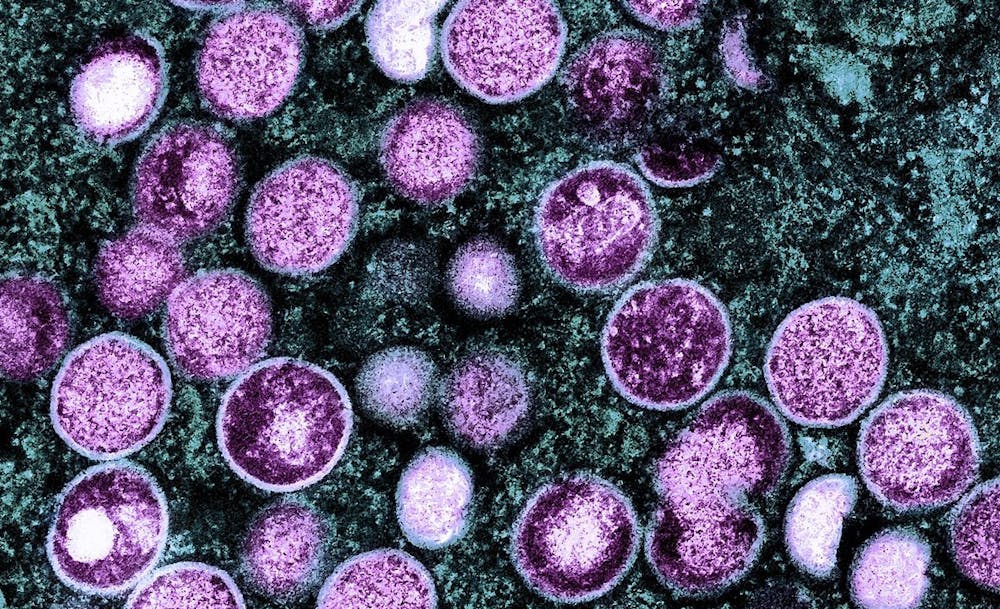Last month, many students began what was their first day of the “normal” college experience: attending classes in 400-person lecture halls, grabbing food with large groups of friends and walking around campus unmasked. The months of wondering “Will this ever end?” seemed to be over as the first fully in-person semester since the fall of 2019 commenced.
With many students having advocated for change to heavy restrictions on academic and student life in the midst of the COVID-19 pandemic, the university’s more lax approach to monkeypox may have seemed initially appealing, but it still raises concerns about student health and safety.
With monkeypox cases rising nationwide, preventative measures similar to those during the COVID-19 pandemic are still encouraged, with particular emphasis on avoiding contact with individuals who have the virus. On August 19, University administration sent out a campus-wide email with updates regarding the status of monkeypox. No significant changes to academic or student life were instated; preventative measures were emphasized, such as avoiding skin-to-skin contact with others.
While the lack of restrictions and return to normal is exciting, it is important to consider this balance between health and safety of the greater student body and the enjoyment of a restriction-free school year. With shortages of the monkeypox vaccine and long processes to determine eligibility, having a vaccinated student body is virtually impossible at this time.
An emphasis on preventative measures as recommended by the Centers for Disease Control and Prevention (CDC) seems to be the University’s best option, and many other schools have followed suit, including Pennsylvania State University, where there has already been a case of the virus among the student body.
On one hand, students are accustomed to taking these preventative measures after undergoing two years of the COVID-19 pandemic. They know how to adapt when faced with a contagious illness, which may help minimize the spread of monkeypox.
But with the return of large-scale events and classes, it is often difficult to implement these measures, particularly avoiding physical contact with others. At events such as the Student Involvement Fair (SIF), which took place in early September, having hundreds of students cramped in one room made it virtually impossible to avoid skin-to-skin contact.
Rather than re-implementing certain restrictions to prevent the spread of monkeypox, which may result in student complaints, better planning for such events with the consideration of public health risks may mitigate this. For example, hosting a huge event like SIF outside, rather than in an enclosed space, would provide students more room to spread apart and be able to avoid close contact with others.
Additionally, planning virtual alternatives for students will make students who are sick more likely to stay home and not infect others, rather than feeling pressured to attend huge lectures to avoid missing notes or exams. Currently, many classes do not offer online options and do not have makeup options if students are sick for exams, which encourages students to do everything they can to attend classes.
As you walk through a lecture hall, you are bound to hear multiple students coughing and sneezing at any given time. It has become so normal for students to attend lectures when not feeling well. A monkeypox rash may be easily overlooked by someone who is not educated on the symptoms of the virus, causing them to attend classes and further spread it. Additionally, the CDC recommends avoiding contact with objects someone with monkeypox has used, which would be nearly impossible in lecture halls where students use the same desks and chairs.
In 2018, when an outbreak of hand, foot and mouth disease occurred on campus, the Student Health and Wellness Center posted signs educating students about the virus in areas on campus with heavy foot traffic. The University should take a similar educational approach with monkeypox to ensure that students know the risks and symptoms in order to successfully prevent the spread.
A larger emphasis on education surrounding the virus can also help to relieve any associated stigmas, such as the misinformation spreading throughout the news that the virus only spreads among sexually active men in the LGBTQIA+ community, many uninformed students may incorrectly assume that they cannot contract the virus.
While the University’s policies play a huge role in public health, it is ultimately up to the student body to adhere to these preventative measures to keep each other safe. At the end of the day, it is much easier to spend an extra minute washing your hands than to endure monkeypox.
Julia Zacharski is a sophomore from Long Island, N.Y. majoring in Molecular and Cellular Biology.





